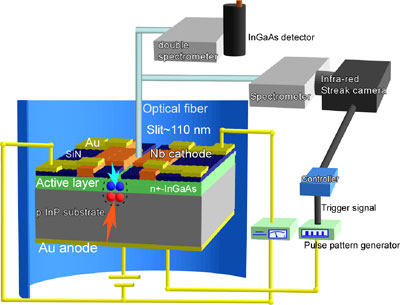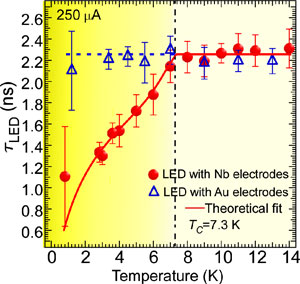Dr. Hirotaka Sasakura, Assistant Professor, and Dr. Hidekazu Kumano, Associate Professor, Dr. Ikuo Suemune, Professor, and their colleagues in the Laboratory of Nano-Photonics, Research Institute for Electronic Science, Hokkaido University, have created an LED structure with superconducting electrodes that emits photons in an optical-fiber communication wavelength band, and have demonstrated that the photon generation process is amplified thanks to the contribution of the Cooper pair. Toward the commercialization of next-generation quantum information processing technologies, a superconductor has been regarded as a promising candidate to realize a quantum bit with a high level of quantum stability and a high-efficiency single photon detector, and has thus been the target of considerable research and development. However, an academic base for the interdisciplinary field between a photon as an information transmission medium and superconductivity has so far not been established. A superconducting electron forms an electron pair through an electron-lattice interaction, such that they are bosonized. An electron pair in this state spatially diffuses, forming a coherent state. If a semiconductor or other normal conductor is bonded to a superconductor in such a coherent state, the electron pair will enter the semiconductor as a result of the proximity effect. It has been predicted that the involvement of this pair in a normal semiconductor band-to-band light-emitting process would lead to a photon generation process that differs from the conventional processes. Our research group fabricated a p-InP/n-InGaAs LED structure (Figure 1) that is equipped with superconducting niobium (Nb) electrodes and measured the transient change in electro luminescence of the LED structure. As a result, we confirmed the effect of enhancing the photon generation process below the superconducting transition temperature of the niobium electrodes (Figure 2). The present result based on the hybrid structure of the superconductor and semiconductor has provided a step not only to the photon source application for the generation of a high-efficiency single photon and photon pair used for quantum cipher communications, but also to a new academic area of superconducting photonics.
The relevant research was jointly conducted by Kazunori Tanaka, Researcher (Hamamatsu Photonics), Tatushi Akazaki, Researcher (NTT Basic Research Laboratories), Dr. Hideaki Takayanagi, Professor (Tokyo University of Science), and Dr. Yasuhiro Asano, Associate Professor (Hokkaido University), based on the "Photonics and Quantum Optics for the Creation of Innovative Functions" promoted by the JST Strategic Basic Research Programs.











